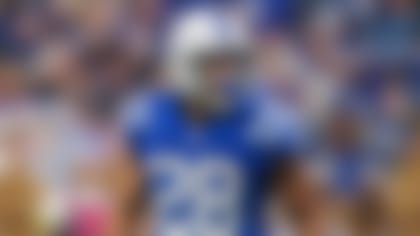Back in my day (circa 2010), the road to fantasy football advice was simple and straight, if a bit narrow. Our options were limited, but there wasn't much risk of getting lost along the way.
Not anymore.
You know that scene in Star Wars: Episode II -- Attack of the Clones when Anakin and Obi-Wan are chasing an assassin through the multi-layered skylanes of Coruscant? Yeah, this is 2023. There are several times more fantasy analysts than NFL players and the flood of hot takes could turn Green Bay into Las Vegas. It's a mess. No one can remember 99 sleepers. We aren't droids.
What you need is a nice, neat list of tips to elevate your understanding of the game. I'm not talking "Don't draft your kicker and defense until the end" or "Know your league settings" -- although those are both excellent pieces of advice. No, I mean a curated collection of specific, actionable DO's and DON'Ts to improve your draft strategy. These aren't Jedi mind tricks. I don't want to sell you death sticks. Have we exhausted the Star Wars references yet? Yes?
All right, here we go. Let's start with what to do in your fantasy drafts for the 2023 season.
NOTE: All info is based on default NFL.com fantasy roster settings and scoring (1 QB, PPR, etc.), as well as 12-team league formats.
DO ...
... get at least one running back in the first four rounds. I know, zero RBs sounds like a fun strategy -- it's not. It's difficult, stressful and volatile; it's possible to succeed with waiver wizardry and some luck, but it's simply not a reliable strategy. You know what is reliable? A running back with 200 fantasy points. You know where they live? In the first four rounds. Nineteen backs had 200+ fantasy points in 2022. Fourteen of them had an average draft position in the first four rounds -- including all of the top six finishers. These guys are anchors. Get one.
... account for changes in coaching and personnel. The Lions went from a bottom-10 offense in 2021 to a top-five unit in 2022. What changed? A new offensive coordinator in Ben Johnson. The minds on the sidelines are often just as important for fantasy as the lads in pads -- it helps to know both. Are you aware the Ravens signed Odell Beckham Jr., drafted Zay Flowers and hired potentially pass-happy OC Todd Monken this offseason? If not, start reading. I recommend my colleague Adam Rank's State of the Franchise series as a great primer.
... target top-tier offenses. This one kind of explains itself. Teams that score more points and gain more yards typically consist of players who score more points and gain more yards. Wild, I know. Some of my less obvious favorites in 2023: the Ravens, Jets, Dolphins and Vikings.
... follow the volume. At their core, fantasy points are the mathematical product of two variables: volume and efficiency. Of the two, volume is much more predictable, and that makes it a cornerstone of player projections. When looking at the top 12 WRs in each of the past five years, all 60 of those WRs had triple-digit targets and more than half had at least 140.
| Target threshold | Percent of WRs to hit threshold |
|---|---|
| 140+ | 55% (33/60) |
| 120+ | 88.3% (53/60) |
| 100+ | 100% (60/60) |
The data is similar at every position. Follow the opportunities and you'll find the value -- e.g. Alexander Mattison and Chigoziem Okonkwo in my list of 2023 breakout candidates.
... consider an elite quarterback -- but at the right price. For years, the prevailing wisdom in fantasy was to wait on a quarterback. And while that is still a valid approach, the tides are shifting. There are now a select few QBs capable of posting 24+ fantasy points per game: Patrick Mahomes, Josh Allen and Jalen Hurts in the second round of your average leagues, and potentially Joe Burrow, Lamar Jackson and Justin Herbert in the third or fourth rounds. It was once foolhardy to grab a QB this early, given the minimal drop-off in positional value several rounds later. No longer. These guys are so much better than the Kirk Cousinses of the world that they're worth the elevated price point.
Ideally, I'd like to get one of them after the middle of the second round, which makes the second trio even more exciting at their price. Either way, if you don't want to play the dart-throw-at-Derek Carr game anymore, I don't think you have to.
... stash upside on your bench. You will likely be tempted late in drafts by the security and (bench) warmth offered by seemingly safe fantasy backups. Flee this temptation, lest you stumble and fall into fourth-place purgatory. Bye-week fillers like Hunter Renfrow and Van Jefferson are not the stuff of fantasy championship teams. Aim for the moon. You might just land some stars (*wipes tear*).
... handcuff running backs -- from other managers' teams. The easiest way to follow the "bench upside" tip? Draft the handcuffs -- or backups -- for other managers' starters. Common knowledge says, "Draft Saquon Barkley in Round 1, then snag Matt Breida with your last pick." But we aren't common people. Instead, draft Saquon and then snag Jerome Ford (Nick Chubb's handcuff) or Zamir White (Josh Jacobs' handcuff, now that Jacobs has signed a one-year deal with the Raiders) and set yourself up for added upside value.
... target (the right) rookies. If you're not too familiar with the 2023 rookie class, let me introduce you (rapid fire edition, ADP included).
Bijan Robinson (Round 1) and Jahmyr Gibbs (Rounds 3-4) are top-echelon running backs. Jordan Addison, Zay Flowers, Jaxon Smith-Njigba and Quentin Johnston are intriguing wideouts with target-dependent upside (Rounds 8-11). Anthony Richardson is a risky but exciting quarterback who could rush his way into a QB1 finish (Round 10). Dalton Kincaid is building enough hype to make him a dart-throw consideration (Round 11). And there are several interesting (upside!) bench prospects toward the end of drafts.
I like targeting Robinson, Gibbs, Addison, Flowers and Richardson. But do some research and find your own favorites!
... draft players you actually like. On that note, this tip is near and dear to my heart. For most of you, fantasy football is about having fun. So, have fun! Draft players you will actually root for. Be a bit of a homer. Buy your RB1's jersey. Enjoy the experience.
If you were (or still are) the type of kid whose fervor to do something increased when your parents told you not to do it, this next section is going to be tough. Bear with me. I promise it's for your own good.
DON'T ...
... buy the injury-prone narrative. With rare exceptions, players are not injury prone just because they've missed games in consecutive seasons. Keenan Allen was supposedly injury prone until 2017, when he finished as the WR3 overall. Christian McCaffrey was said to be injury prone heading into last season, when he finished as the RB2 overall. A lot of NFL injuries are freak accidents, not the product of soft bones or brittle hammies.
Some of my favorite so-called injury prone players to buy this year: Lamar Jackson, Tua Tagovailoa, George Kittle, Jerry Jeudy, James Conner and Rashaad Penny.
... fall prey to recency bias. Listen, I get it. It's human nature. Fight it! Don't allow the truths of the past to be obscured by the flukes of the slightly less distant past. Yes, Cooper Kupp (and his QB) missed the second half of the 2022 season. He has also averaged 24.7 fantasy points per game since 2021 -- most in the NFL at any position. Take recent events with a grain of salt (that tastes like all the events prior).
... be beholden to ADP, especially in later rounds. As the wise sage Captain Barbossa once said, "The [ADP] is more what you'd call 'guidelines' than actual rules." Seriously though, do not let the average draft position dictate your decisions. It is a highly speculative rubric that will be blown to smithereens in Week 1. Don't be afraid to reach or wait a round or two, especially later in the draft -- you decide the opportune moment.
... commit to a specific roster build pre-draft. Perhaps the most crucial tip in this entire article: be adaptable. Do not Sharpie "RB-WR-WR-QB" on your palm and then go on tilt when your plan falls apart in Round 3. If you want to take a tight end early, but miss out on all the elite options, be ready to pivot! All the advice you've read -- here and elsewhere -- is meant as a flexible framework. Be fluid, first and foremost.
... be panicked by RB committees. Twenty years ago (in 2003), 13 running backs finished the season with 300+ carries. Those times are gone. Last year, three guys did it (Derrick Henry, Josh Jacobs, Nick Chubb) and that's above the norm. Running back by committee is the way of the modern NFL, and we have to evolve with it. Combine this with the top-tier offenses tip above and take shots on backfields like Baltimore, Buffalo, Detroit and Miami.
... wait on selecting a wide receiver until the studs are gone. Unlike running backs, it is nearly impossible to find startable wide receivers late in drafts or on the waiver wire. If you want studs (and you should), you almost always need to pay the price. I typically like to walk away with one of the top 20 guys (a tier that ends around Keenan Allen) and at least two over the first seven rounds (staying flexible in the process, of course). Don't get stuck starting Christian Watson and George Pickens. You'll regret it.
... draft an I guess tight end. As Adam Rank was quick to point out in his tight end tiers, Travis Kelce is in his own stratosphere, and then Mark Andrews, T.J. Hockenson and George Kittle are the rest of the likely studs. After that, it's kind of a crapshoot (and this is coming from a diehard Kyle Pitts truther). If you can't snag one of those four, do not become the doofus who says, "The rest of my starting lineup is filled, I guess I'll take Pat Freiermuth at tight end?" Be patient and try to nail value on someone you like.
My personal favorites: Darren Waller (Round 5), Tyler Higbee (Round 12) and Chigoziem Okonkwo (Round 13).
... assign too much value to schedule difficulty. Last season, the Cardinals allowed the third-most points to running backs and the Lions allowed the seventh-fewest. One year prior, Arizona allowed the sixth-fewest and Detroit the fourth-most. The moral of that story: Don't drastically adjust a player's value just because their schedule looks easy or tough based on last year's defensive data. It's hard enough to predict player performance without also incorporating predictions for 32 defenses that tend to fluctuate year-to-year. Consider schedule difficulty as a tiebreaker between two players you like. No more.
... run from risk -- embrace it. At this point, you should have noticed a through line in many of these tips: Reward often requires risk -- don't avoid it. Obviously, be smart. But recognize that the smartest move sometimes means selecting a 21-year-old rookie even though he was the fifth wide receiver taken in his own draft class. Because every now and again, that guy turns out to be Justin Jefferson.
Want to follow these storylines and more? NFL+ gives you the freedom to watch live out-of-market preseason games, daily coverage on NFL Network, the best NFL programming on-demand and much more! Plus, NFL RedZone is now part of NFL+ Premium! Learn more about NFL+.













